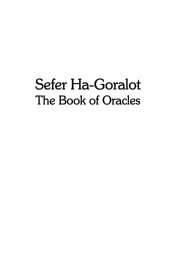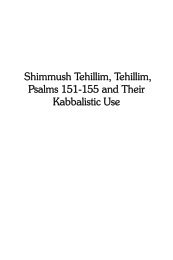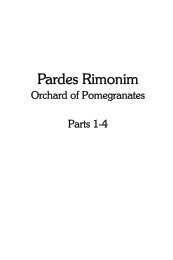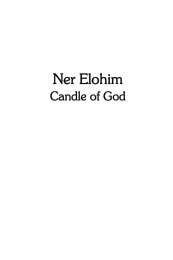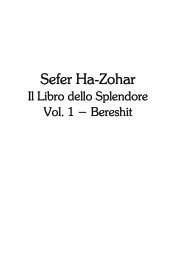Create successful ePaper yourself
Turn your PDF publications into a flip-book with our unique Google optimized e-Paper software.
Sheva Netivot Ha-TorahThe Seven Paths of TorahBy Rabbi Abraham AbulafiaIntegral edition in English and HebrewE-mail: info@everburninglight.<strong>org</strong>WWW: http://www.everburninglight.<strong>org</strong>
Publisher: Providence UniversityFirst Edition, 2006First Reprint, 2007ISBN: 1-897352-00-XCopyright © 2006 by Fabrizio Lanza, ULC-ITALIAFor information:ULC-ITALIAVia C.A. Colombo 20/F, 34074 Monfalcone (GO)Tel.: +39-(0)481-412574All rights reserved for every country. No part of this publication may bereproduced, stored in a retrieval system, or transmitted in any form or by anymeans, electronic, mechanical, photocopying, recording or otherwise, withoutthe prior permission of the publisher.Printed in the United States of America.
viSheva Netivot Ha-Torah – The Seven Paths of TorahPrefaceAbraham ben Samuel Abulafia was born in the year 1240at Saragossa, in Aragon; he died some time after 1291.Very early in life he was taken by his parents to Tudela, inNavarre, where his aged father carefully instructed him inthe Bible and Talmud. When he was eighteen years old hisfather died, and two years later Abraham began a life ofceaseless wandering. His first journey was to Palestinewhere he sought to find the legendary river Sambation andthe lost Ten Tribes. However, he got no further than Acreowing to the desolation wrought in the Holy Land by thelast Crusades. He then determined to go to Rome, butstopped short at Capua where he devoted himself withpassionate zeal to the study of philosophy and of the“Moreh” of Maimonides, under the tutelage of aphilosopher and physician named Hillel — probably thewell known Hillel ben Samuel ben Eliezer of Verona.He always held Maimonides in the highest estimation,and often made use of sentences from his writings, but hewas little satisfied with any other branch of knowledge thathe acquired: he always thirsted after the highest. Being of acommunicative disposition, he was able and eager to teachothers. He wrote industriously on kabbalistic, philosophical,and grammatical subjects, and succeeded in surroundinghimself with numerous pupils to whom he imparted muchof his own enthusiasm. Upon his return to Spain, he beganto experience visions, and at the age of thirty-one, atBarcelona, immersed himself in the study of the SeferYetzirah and its numerous commentaries. This book, andparticularly the commentary and method of the Germanmystic, Eleazar of Worms, exercised a deep influence uponhim, and had the effect of greatly increasing his mystical
Sheva Netivot Ha-Torah – The Seven Paths of Torah viibent. Building on the Sefer Yetzirah, which held languageto be the constitutive force of creation, Abulafia regardedthe letters of the alphabet, their vowel points, as well astheir combinations, permutations, and numericalequivalents, to be symbols and cyphers of existence itself.These discoveries possessed for him an illumining powerthat most effectively propelled him on to a deeper study ofthe divine names; especially of the consonants of theTetragrammaton. With such auxiliaries, and theobservance of certain rites and ascetic practices, mankind,he says, may attain the highest aim of existence andbecome prophets; not in order to work miracles and signs,but to reach the highest degree of perception and be ableto penetrate intuitively into the inscrutable nature of theDeity, the riddles of creation, the problems of human life,as well as the purpose of the precepts, and the deepermeaning of the Torah. His most important disciple and theone who carried his system further, was the kabbalistJoseph Gikatilla.Abulafia soon left Spain again and wrote the first of hisprophetic books, Sefer ha-Yashar (The Book of theRighteous in 1279 at Patras, Greece. In obedience to whathe believed to be an inner imperative, he went to Rome in1280 in order to effect the conversion of Pope Nicholas III,on the day before New Year, 5041. The pope, then inSuriano, heard of it, and issued orders to burn the fanaticas soon as he arrived. Near the inner gate, a stake waserected in preparation. Not in the least disturbed, however,Abulafia set out for Suriano and arrived there on August22. While passing through the outer gate, he heard that thepope had succumbed to an apoplectic stroke during thepreceding night. Returning to Rome, he was thrown intoprison by the Minorites, but was liberated after four weeks’detention. He was later heard to be in Sicily where he
viiiSheva Netivot Ha-Torah – The Seven Paths of Torahappeared as a prophet and Messiah. But this claim (toMessiahship) was laid to rest by a letter to the people ofPalermo that most energetically condemned Abulafia’sconduct. It was written by Rabbi Solomon ben Adret, whostrove with all his power to guide men’s minds arightduring those trying times of hysterical mental confusion.Abulafia had to take up the pilgrim’s staff anew, and underdistressing conditions compiled his Sefer ha-Ot (The Bookof the Sign) on the little island of Comino, near Malta, from1285-88. In 1291, he wrote his last, and perhaps mostintelligible, work, Imre Shefer (Words of Beauty); after thisall trace of him was lost.Abulafia calls his kabbalistic system “PropheticKabbalah”, distinguishing it thus from that of hispredecessors, whose works he considered of a lower gradebecause it satisfied itself with the characterization of God asEn-Sof (Infinite), with the Sefirot as vague intermediaries,and with the doctrine of the transmigration of souls, andbecause its method remained essentially speculative. Suchworks were merely preliminary and an inferior grade ofknowledge; he rather considered the highest goal to beprophecy, that would assure men a certain degree ofcommunity with God and direct experience of the divine.The means to this goal are afforded by the close study ofthe names of God, particularly of the four-lettered YHWH,and by Gematria, the symbolical employment of letters asnumerals. In this system, the letters of a word are notconsidered as mere vocal sounds, but as numerals, the sumof which may be replaced by an equal sum of other letters,producing, of course, a new word that must prove to beidentical in significance, or at least allied with the first wordwhose sum it equals. Thus Abulafia sometimes calls himselfRaziel (רזיאל) and sometimes Zechariah ,(זכריהו) becausethe total of the letters in each of these words equals 248,
Sheva Netivot Ha-Torah – The Seven Paths of Torah ixwhich is likewise the total of the letters in his own givenname Abraham .(אברהם) In one place, desiring to callhimself Berechiah, he misspells it ברכהיהו in order tomake it total 248 (Steinschneider, “Cat. Munich”, No.409). He also employs the processes of Notarikon(regarding each letter in a word as the initial of some otherword, and so making of it an acrostic), of Temurah(substitution of one letter for another), and of Tzeruf(connecting various letters of the same word). He claimedto have derived his system of letter-symbols from MosesNachmanides; but he probably drew it, especially theGematria and the play with the names of God and thenecessary attendant ascetic life and contemplation — that,כוונה) can be summed up in the word Kavvanahintention) — from the German mysticism of Eleazar ofWorms. His view of prophetism or the prophetic gift as thehighest goal seems to point to an influence of Judah ha-Levi’s Kuzari, but his idea of the nature of prophecy itself israther in accord with Maimonides.Owing to Abulafia’s influence, there was a growingtendency to deal with the names of God and angels, and towidely employ Gematria in its most diverse forms. He wasthe first one, moreover, to allow the Christian idea of theTrinity to show a faint glimmer in the Kabbalah.Abulafia began his fruitful literary activity in 1271; hehimself claims the number of his writings to be twenty-six,twenty-two of which are “prophetical”.Due to ben Adret’s influence, Abulafia’s teachings had adifficult course after his death. Even when some of thegreatest kabbalists in history — such as Moshe Kordoveroand Chayyim Vital — mentioned him and cited his works,his texts were studied up to our days only in restrictedcircles devoted to establishing a direct communion with
xSheva Netivot Ha-Torah – The Seven Paths of TorahGod. We can say that Prophetic Kabbalah only began withAbulafia; indeed, we find traces of it across centuries,although it was never taught publicly. Personalities such asYehuda Albotini and the Baal Shem Tov witnessed itsdevelopment.Historically, Abulafia’s books were never committed toprint, until 1853, when Adolph Jellinek published a few ofhis texts. Only around the year 2000 did all of his worksbegin to be published, which testifies the high degree ofsecrecy that always surrounded this author.In Jellinek’s preface to Sefer ha-Ot, we read,“In the Spaniard Abraham Abulafia of the thirteenth century,Essenism of old found its resurrection. Preaching asceticism andthe highest potentiality of the spirit through communion with God,effected by a perfect knowledge and use of His names, he wasthoroughly convinced of his prophetic mission, and consideredhimself to be the God-sent Messiah and Son of God. He differs,however, from the Messiahs who have risen at different times inhis many-sided philosophical training as well as in his perfectunselfishness and sincerity. He addresses himself not to themasses, but to the educated and enlightened, and does notconfine his mission to his coreligionists, but is filled with thedesire to extend it to the adherents of the Christian church also.It seems that, for the sake of influencing these, he tried toconstruct a Trinitarian system, though it was a Trinity in formmerely, and did not touch the essence of God’s personality.Before his vision stood the ideal of a unity of faith, the realizationof which he longed to bring about. Imbued with this spirit, hisdisciples worked in Spain and Italy, emphasizing still more theTrinitarian idea while treating of the ‘Ten Sefiro’ in order to winthe adherents of the Church. Hence the terms Father, Mother,Son, and Holy Ghost, borrowed from the Christian creed, in thekabbalistic literature of the thirteenth century. In order tounderstand Abulafia psychologically and judge him correctly andwithout bias in the light of history, it must be borne in mind thathis cradle was in Spain, the home of religious ecstasy, and thatthe age in which he lived was that of the Crusades, so favorable
Sheva Netivot Ha-Torah – The Seven Paths of Torah xito mystic speculation, an age in which many longed to see thebarriers separating Judaism, Christianity, and Islam brokendown, and in which the Messianic hopes of the Jews found newnourishment in many hearts”.From Sefer ha-Ot we discover Abulafia’s vision aboutProphetic Kabbalah:“Those who are called prophets meditate in their hearts on thechanging substance of their thoughts, and their deliberations arepurely subjective. The light of God illumines some of theirthoughts, sometimes with a tiny light. They themselves recognizethat this emanates from outside themselves, but they receivedno verbalized message that they should recognize as speech —it is only light. From this stage they rise from light to light, throughmeditation on the ramification of their thoughts, which arerendered sweet by their fusion with the divine realm. Through theenhancement of their merit they approach the highest distinctionto a point where the speech they hear within themselves is linkedwith the fountain from which all speech derives. They ascendfrom speech to speech until their inner speech is potent in itselfand becomes ready to receive the divine speech, whether it be inthe form of speech, or the contents of the speech itself. Theseare the true prophets, in justice and in righteousness”.Jay Michaelson, a contemporary scholar of Abulafia andKabbalah, tells us:“From what we know of Abulafia’s biography — based on hisown accounts, and those of outside sources — he lived a veryunusual life for a Kabbalist. Most of the important Kabbalists ledrelatively conventional lives: they had families and roots in theirrespective communities. Some, such as Rabbi Joseph Caro,were famous rabbis and legal authorities. Not Abulafia. Althoughthe first part of his life did resemble these more conventionalmodels, he eventually became an itinerant mystic, traveling fromtown to town, attracting students, and leading a mystical lifeapart from communal and familial obligations. It's possible thatthis lifestyle accounts for how widespread Abulafia’s teachingsbecame, although it's also true that his unorthodox ways andecstatic mystical practices angered more than a few rabbis in the
xiiSheva Netivot Ha-Torah – The Seven Paths of Torahcommunities he visited. It’s easy to see why Abulafia’s ideaswould be perceived as threatening if we take a step back to lookat the Prophetic Kabbalah in the context of a received religioustradition. For most traditional Jews, including those today,revelation is a very limited occurrence. It takes place in theTorah, and is given to the prophets of the Bible — but prophecystopped over two thousand years ago, and since then, our taskhas been to debate and discuss the meanings of the alreadyreceivedrevelation. And yet, Abulafia teaches that, by using hismethods of letter permutation, meditation, and free association,you can receive prophecy today. This can be a radicallydestabilizing notion. What if your prophecy contradicts therevealed word of God? What if the Active Intellect reveals to yousomething which goes against Halacha, or conventionalinterpretations of Scripture? If prophecy is truly available toeveryone, then the authority of those with privileged access tothe Divine by means of the textual tradition is undermined. InAbulafia’s own case, sometimes he was careful on these points,and other times strikingly bold. Reading his texts, one quicklynotices that the most radical and destabilizing ideas are oftencouched in abstruse Gematria or mystical allegory. Often, likeMaimonides, Abulafia will not quite say what he means directly,purposely leaving what would today be called a ‘constructiveambiguity’. Hameivin yavin: he who understands, understands”.We are proud to present the first translation ever done ofa work by Abulafia in the English language. Sheva NetivotHa-Torah shows the typical abulafian style, albeit heappears very concerned to defend himself from the attacksof ben Adret. Abulafia leads the reader to progressivelydeeper thoughts, demonstrating to him the superiority ofKabbalah above every other branch of knowledge. Thanksto his encyclopedic culture, he takes into account all theknown sources of his age, and compares them toKabbalah. His observations are quite astonishing andaccurate. Moreover, his close examination of how thehuman mind works rivals the most modern theories inpsychology. His method, as he describes it, is “scientific”.This, in fact, means that whoever engages in its practices is
Sheva Netivot Ha-Torah – The Seven Paths of Torah xiiiguaranteed to penetrate into the higher worlds and tofinally reach God. However, things are not as easy as theymay first appear: there are many paths, according to one’sspiritual level. Precisely, there are seven paths, and this iswhat this book is about.Finally, a special thanks to Fabrizio Lanza, Kathryn Smithand Talib Din for their support in this translation project.



